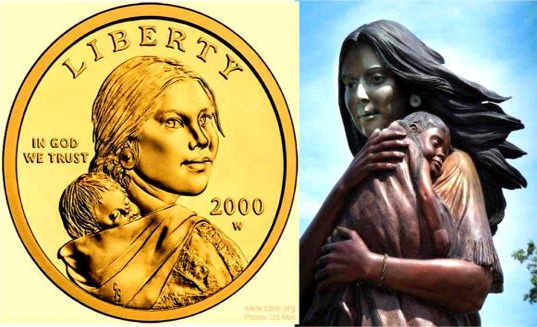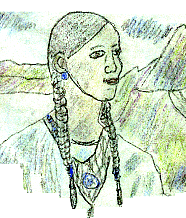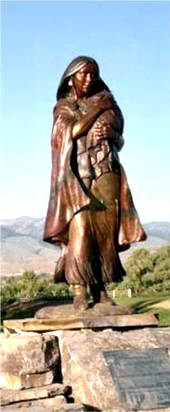|
SACAGAWEA
Sacagawea (Sacajawea) was born around 1788 in a Shoshone tribe in the
Rocky Mountains of what is now Idaho. She was taken from this tribe by
an Hidatsa raiding party around the age of eleven, and then later sold
into slavery to Missouri River Mandans near Bismark, ND. It was from
here, at the age of fifteen,
that she was sold her to Toussaint Charbonneau, a French-Canadian fur
trader, making her one of at least two wive's. In November 1804,
Meriwether Lewis and William Clark, appointed by President Thomas
Jefferson to chart a passage way through the western territories and
Pasific Northwest to the Pacific Ocean, arrived in the area with the
Corps of Discovery and built Fort Mandan. Soon after, on February 4,
1805, Sacagawea gave birth to her son Jean-Baptiste Charbonneau. About
this time, Lewis and Clark hired Charbonneau to act as a guide and
interpreter for their expedition, but the explorers were likely equally,
if not more, interested in having Sacagawea accompany them as well.
Because she was Shoshone, she knew several Indian languages and would
proove to be indispensable on their journeys. Lewis and Clark knew that
they would have to buy horses from the Shoshone in order to cross the
Bitterroot Mountains and complete their expedition - Sacagawea could
help them with this. The 33-member expedition left Fort Mandan in April
of 1805, with Charbonneau, Sacagawea, and infant Jean-Baptiste strapped
to her back as well. Sacagawea prooved not only to be indispensible in
purchases horses from her Shoshone (coincidentally, from her long-lost
brother Chief Cameahwait), but in numerous other areas as well. She was
extremely familiar with the the territory the expedition traversed, and
knew much about edible and medicinal plants and roots of which they
could take advantage. More importantly, Sacagawea and her infant acted
as a sign of peace for the military and scientific expedition. Because
Native Americans knew that war parties were never accompanied by a woman
and infant, the response was curiosity rather than hostility. Due
greatly to Sacagawea's presence, no member of the expedition was lost to
hostility - amazing considering most Native Americans at that time had
never even seen a white man. At one point during the expedition, a canoe
she and Captain Clark were in on the Missourii River capsized in
dangerous whitewater, and Sacagawea (with her Jean Baptiste on her
back), rescued Captain Clark's journals from the water, saving much of
Clark's documentation of the first year of the expedition. It was these
types of actions that earned Sacagawea immense respect from Lewis and
Clark. On August 14, 1806 the Corps of Discovery returned to the
Hidatsa-Mandan villages, having successfully made it to the Pacific
Ocean and back. While Charbonneau was paid $500.33 and given 320 acres
of land for his services, Sacagawea was paid nothing. However, Lewis and
Clark were deeply indebted to her, and in fact, six years later Clark
legally adopted both Jean Baptiste and Sacagawea's second child, and
girl named Lisette born in 1812. Sacagawea died at the young age of 25
on December 22, 1812 at Fort Manuel, a Missouri Fur Company trading post
in present-day South Dakota. She had suffered much of her life from some
sort of ailment, which in fact nearly took her life once during the
expedition. Sacagawea's contributions as guide, interpreter, and
peacemaker were monumental. indispensable on their journeys. Lewis and Clark knew that
they would have to buy horses from the Shoshone in order to cross the
Bitterroot Mountains and complete their expedition - Sacagawea could
help them with this. The 33-member expedition left Fort Mandan in April
of 1805, with Charbonneau, Sacagawea, and infant Jean-Baptiste strapped
to her back as well. Sacagawea prooved not only to be indispensible in
purchases horses from her Shoshone (coincidentally, from her long-lost
brother Chief Cameahwait), but in numerous other areas as well. She was
extremely familiar with the the territory the expedition traversed, and
knew much about edible and medicinal plants and roots of which they
could take advantage. More importantly, Sacagawea and her infant acted
as a sign of peace for the military and scientific expedition. Because
Native Americans knew that war parties were never accompanied by a woman
and infant, the response was curiosity rather than hostility. Due
greatly to Sacagawea's presence, no member of the expedition was lost to
hostility - amazing considering most Native Americans at that time had
never even seen a white man. At one point during the expedition, a canoe
she and Captain Clark were in on the Missourii River capsized in
dangerous whitewater, and Sacagawea (with her Jean Baptiste on her
back), rescued Captain Clark's journals from the water, saving much of
Clark's documentation of the first year of the expedition. It was these
types of actions that earned Sacagawea immense respect from Lewis and
Clark. On August 14, 1806 the Corps of Discovery returned to the
Hidatsa-Mandan villages, having successfully made it to the Pacific
Ocean and back. While Charbonneau was paid $500.33 and given 320 acres
of land for his services, Sacagawea was paid nothing. However, Lewis and
Clark were deeply indebted to her, and in fact, six years later Clark
legally adopted both Jean Baptiste and Sacagawea's second child, and
girl named Lisette born in 1812. Sacagawea died at the young age of 25
on December 22, 1812 at Fort Manuel, a Missouri Fur Company trading post
in present-day South Dakota. She had suffered much of her life from some
sort of ailment, which in fact nearly took her life once during the
expedition. Sacagawea's contributions as guide, interpreter, and
peacemaker were monumental.
pbs.org
- katecampbellstevenson.com/sacagawea.htm
Sacajawea Gives Birth to Young Explorer Pompey
On February 11, 1805, Jean Baptiste
Charbonneau was born. He was the son of the Lemhi Shoshone woman called
Sacajawea and her husband Toussaint Charbonneau, at Fort Mandan in what
is now North Dakota. “Pomp,” as Jean Baptiste was soon to be called, was
just a newborn, an infant of two months, when he and his parents left
Fort Mandan on perhaps the longest exploration in U.S. history, the
Lewis and Clark expedition to the Pacific coast, through country largely
unknown to the non-Native world. Pomp would be the country’s youngest
explorer.
Captain Lewis was not only the leader of the expedition, but also served
as the doctor. He was present at the birth of the baby and reported “her
labour was tedious and the pain violent.” He was counseled by others to
crush the rattles from a rattlesnake and mix that with water to help
induce birth. Although skeptical, it seemed to work, as Sacajawea gave
birth soon after.
Two months later, on April 7, 1805, the expedition left Fort Mandan with
Sacajawea and Pomp traveling up the Missouri in a pirogue. The
expedition would not end for another 17 months when they returned to St.
Louis.
jack mcneel -
indiancountrytodaymedianetwork.com - 2014
What
 happened to Sacagawea's children ? happened to Sacagawea's children ?
After her death, Toussaint
Charbonneau signed over complete custody of his son Jean-Baptiste and his
daughter Lisette over to William Clark. It is believed Lisette died in infancy,
but Jean-Baptiste was educated by Clark in St. Louis and then, at age 18 was
sent to Europe. He would learn to speak English, French, Spanish and German and
joined in the California gold rush. In May 1866, while returning from
California, Charbonneau died of pneumonia near Danner, Oregon at age 61.
http://wiki.answers.com
Jean Baptiste
Charbonneau -- "Little Pomp" "PoMPEY"
- to William Clark -- was educated in St. Louis under
Clark's supervision and later became a traveling companion to a German prince,
who took him to Europe for five years, where he learned several languages.
Baptiste returned to America and for awhile became a mountain (the explorer John
C. Fremont mentions in his journals encountering him.) During the war with
Mexico in 1846, Baptiste was hired by the Army to guide the Mormon Battalion
from Fort Leavenworth, Kansas, all the way to California, where he became
a magistrate of San Luis Rey Mission in California after the conflict. In 1866,
at age 61, he learned of gold discoveries in Montana and set off with a wagon
train for the gold fields, but caught pneumonia along the way and died on May 16
in southeastern Oregon.
A historical marker near the town of Danner marks the spot. I'm unaware of any
information about the fate of Sacagawea's daughter, Lisette. More
information about Baptiste (and Sacagawea and Toussaint Charbonneau) is
available from a pamphlet published by the Fort Clatsop Historical Association,
"A Charbonneau Family Portrait by Irving W. Anderson. (Fort Clatsop National
Memorial -- 503-861-2471 -- sells it in their bookstore.) Anderson's
pamphlet also examines the two competing theories about the time and place
of Sacagawea's death. He concludes (as do most historians) that it was December
20, 1812, at Fort Manuel near today's Kenel, South Dakota; not many years
later, at the age of 100, on the Wind River Indian Reservation in
Wyoming ...
pbs.org
Sacagawea was born around 1790. She was the daughter of a Shoshone chief. At
about the age of 10, she was kidnapped by the Hidatsas during a raid against the
Shoshones. Her father was killed. She then lived hundreds of miles away in a
Hidatsa village on the upper Missouri where she was either sold or gambled away
to Charbonneau, a French-Canadian trapper. As was custom in the Indian villages,
Charbonneau had multiple wives.
l3-lewisandclark.com

Six years after the expedition, Sacagawea gave birth to a
daughter, Lisette. On December 22, 1812, the Shoshone woman died at age 25 due
to what later medical researchers believed was a serious illness she had
suffered most of her adult life. Her condition may have been aggravated by
Lisette’s birth.
At the time of her death, Sacagawea was with her husband at
Fort Manuel, a Missouri Fur Company trading post in present-day South Dakota.
Eight months after her death, Clark legally adopted Sacagawea’s two children,
Jean Baptiste and Lisette. Baptiste was educated by Clark in St. Louis, and then,
at age 18, was sent to Europe with a German prince. It
is not known whether Lisette survived past infancy.
geocities.com/impurplehawk/sacagawea.html
The court appoints William Clark Guardian to the
infant children of Toussaint Charbonneau deceased, to wit, Toussaint Charbonneau
a boy about the age of ten years old and Lisette Charbonneau a girl about one
year old.
Orphans Court record . St Louis -
August 11, 1813
lewisandclarktravel.com
- 2008
"The last recorded document citing Sacagawea's
existence appears in William Clark's original notes written between 1825-1826.
He lists the names of each of the expedition members and their last known
whereabouts. For Sacagawea he writes: "Se car ja we
au- Dead" - Jackson, 1962."
It is not believed that Lizette survived childhood, as there is no later record
of her among Clark's papers
http://en.wikipedia.org/wiki/Sacagawea
Sacagawea was a Shoshone,
growing up in the Rocky Mountains. A Hidatsa war party captured her when she
about 12 years old. She was traded as a slave to Toussaint Charbonneau, a
French-Canadian fur trader who treated her and another native American woman as
his wives. Lewis and Clarke and the Corps of Discovery in November 1804, arrived
at the Hidatsa-Mandan villages and built a fort nearby. Sacagawea on February
11, 1805, gave birth to her son Jean-Baptiste Charbonneau. She was only about
16 years old. Charbonneau with Sacagawea was hired as an interpreter. Sacagawea,
with the infant Jean Baptiste, was the only woman to accompany the 33 members of
the permanent party to the Pacific Ocean and back. She proved to be invaluable
to the expedition, and not just as an interpreter. She helped identify edible
roots and berries, deal with overturned boats, bargan for horses, guide them,
and much more.
Despite
the fact that she had just given birh and had an infant son, she kept up with
the men on their arduous journey. Her husband was paid, but not Sacagawea. After
the expedition she gave birth to a daughter, Lisette. Sacagawea died on December
22, 1812, when she was about 25 years old.
histclo.com
After her death, Toussaint Charbonneau signed over complete custody of his son
Jean-Baptiste and his daughter Lisette over to William Clark.
It is believed Lisette died in infancy but Jean-Baptiste was educated by
Clark in St. Louis and then, at age 18 was sent to Europe. He would learn to
speak English, French, Spanish and German and joined in the California gold
rush. In May 1866, while returning from California,
Charbonneau died of pneumonia near Danner, Oregon at age 61.
wiki.answer.com
pbs.org
...
Sacajawea
died at Fort Manuel
South Dakota on December 20, 1812
soon after givingbirth to a
daughter called Lisette
although
there is an alternate theory that she lived to be
avery old woman, living on the Wind River
Indian
Reservation, Wyoming.
After Sacagawea’s death, William Clark adopted her two children,
Jean Baptiste and Lisette.
museumofidaho.org
http://inquiryunlimited.org/bk/sbks/ar/lewisclkar.htm
|


